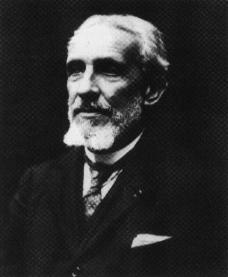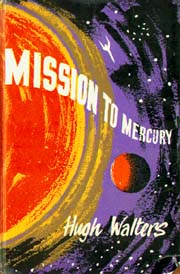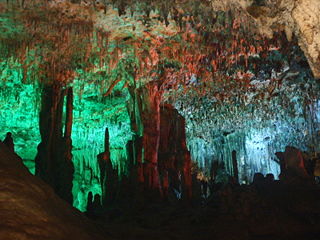
The Hollow Earth is a concept proposing that the planet Earth is entirely hollow or contains a substantial interior space. Notably suggested by Edmond Halley in the late 17th century, the notion was disproven, first tentatively by Pierre Bouguer in 1740, then definitively by Charles Hutton in his Schiehallion experiment around 1774.
William Sydney Graham was a Scottish poet, who was often associated with Dylan Thomas and the neo-romantic group of poets. Graham's poetry was mostly overlooked in his lifetime; however, partly thanks to the support of Harold Pinter, his work was eventually acknowledged. He was represented in the second edition of the Penguin Book of Contemporary Verse and the Anthology of Twentieth-Century British and Irish Poetry.

Hugh Barnett Cave was an American writer of various genres, perhaps best remembered for his works of horror, weird menace and science fiction. Cave was one of the most prolific contributors to pulp magazines of the 1920s and '30s, selling an estimated 800 stories not only in the aforementioned genres but also in western, fantasy, adventure, crime, romance and non-fiction. He used a variety of pen names, notably Justin Case under which name he created the antihero The Eel. A war correspondent during World War II, Cave afterwards settled in Jamaica where he owned and managed a coffee plantation and continued his writing career, now specializing in novels as well as fiction and non-fiction sales to mainstream magazines.

Subterranean fiction is a subgenre of adventure fiction, science fiction, or fantasy which focuses on fictional underground settings, sometimes at the center of the Earth or otherwise deep below the surface. The genre is based on, and has in turn influenced, the Hollow Earth theory. The earliest works in the genre were Enlightenment-era philosophical or allegorical works, in which the underground setting was often largely incidental. In the late 19th century, however, more pseudoscientific or proto-science-fictional motifs gained prevalence. Common themes have included a depiction of the underground world as more primitive than the surface, either culturally, technologically or biologically, or in some combination thereof. The former cases usually see the setting used as a venue for sword-and-sorcery fiction, while the latter often features cryptids or creatures extinct on the surface, such as dinosaurs or archaic humans. A less frequent theme has the underground world much more technologically advanced than the surface one, typically either as the refugium of a lost civilization, or as a secret base for space aliens.

Édouard-Alfred Martel, the 'father of modern speleology', was a world pioneer of cave exploration, study, and documentation. Martel explored thousands of caves in his native France and many other countries, popularised the pursuit of cave exploration, introduced the concept of speleology as a distinct area of scientific study, maintained an extensive archive, and in 1895 founded Société de Spéléologie, the first organisation devoted to cave science in the world.

A yaodong or "house cave" is a particular form of earth shelter dwelling common in the Loess Plateau in China's north. They are generally carved out of a hillside or excavated horizontally from a central "sunken courtyard".

The New Oxford Book of Carols is a collection of vocal scores of Christmas carols. It was first published in 1992 by Oxford University Press (OUP) and was edited by Hugh Keyte and Andrew Parrott. It is a widely used source of carols in among choirs and church congregations in Britain.
Tobias Hill is a British poet, essayist, writer of short stories and novelist.
Hugh Walter Kelsey was a British bridge player and writer, best known for advanced books on the play of the cards.
Hugh Walters was a British writer of juvenile science fiction novels from Bradley in the West Midlands region of the United Kingdom.

Blast Off at Woomera is a children's science fiction novel, the first in the Chris Godfrey of U.N.E.X.A. series by British author Hugh Walters. It was published in the UK by Faber in 1957, in the USA by Criterion Books in 1958, and in the Netherlands in 1960 by Prisma Juniores.

Destination Mars is a juvenile science fiction novel, the sixth in Hugh Walters' Chris Godfrey of U.N.E.X.A. series. It was published in the UK by Faber in 1963 and in the US by Criterion Books in 1964. Also published in German by Schneider Buch as Der Chor der Verdammten in 1983, and in Portuguese by Galeria Panorama in 1969 as Destino Marte.

Mission to Mercury is a juvenile science fiction novel, the ninth in Hugh Walters' Chris Godfrey of U.N.E.X.A. series. It was published in 1965 in the UK by Faber and in the US by Criterion Books. Also published under the name Missão Mercúrio in Portugal by Galeria Panorama.

Nearly Neptune is a juvenile science fiction novel by British writer Hugh Walters, the twelfth in his Chris Godfrey of U.N.E.X.A. series. It was published in the UK by Faber in 1969 and in the US by Washburn Books under the title Neptune One is Missing.

Tony Hale, Space Detective is a juvenile science fiction novel, the fifteenth in Hugh Walters' Chris Godfrey of U.N.E.X.A. series. It was published in the UK by Faber in 1973.

The Last Disaster is a juvenile science fiction novel, the eighteenth in Hugh Walters' Chris Godfrey of U.N.E.X.A. series. It was published in the UK by Faber in 1978

The Dark Triangle is a juvenile science fiction novel, the twentieth and last published in Hugh Walters' Chris Godfrey of U.N.E.X.A. series. It was published in the UK by Faber in 1979. One final book - The Glass Men - was written, but was never published.

The Caves of Drach are four great caves that are located in the island of Majorca, Balearic Islands, Spain, extending to a depth of 25 m and reaching approximately 4 km in length. They are in the municipality of Manacor, near the locality of Porto Cristo. They were first mentioned in a letter dated 1338. The four caves, called Black Cave, White Cave, Cave of Luis Salvador, and Cave of the French, are connected to each other.
Hugh Brody is a British anthropologist, writer, director and lecturer.

The Coves dels Hams are a Solutional cave system on the east coast of the Spanish Balearic Island of Mallorca. The caves are in the municipality of Manacor, about 1 km to the west of the town of Porto Cristo.















